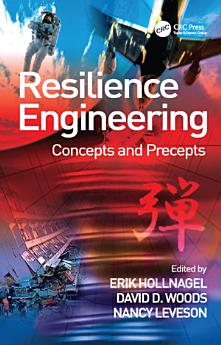Resilience Engineering: Concepts and Precepts
নৱে ২০১৭ · CRC Press
৩.৫star
২ টা পৰ্যালোচনাreport
ইবুক
416
পৃষ্ঠা
family_home
যোগ্য
info
reportমূল্যাংকন আৰু পৰ্যালোচনা সত্যাপন কৰা হোৱা নাই অধিক জানক
এই ইবুকখনৰ বিষয়ে
For Resilience Engineering, 'failure' is the result of the adaptations necessary to cope with the complexity of the real world, rather than a breakdown or malfunction. The performance of individuals and organizations must continually adjust to current conditions and, because resources and time are finite, such adjustments are always approximate. This definitive new book explores this groundbreaking new development in safety and risk management, where 'success' is based on the ability of organizations, groups and individuals to anticipate the changing shape of risk before failures and harm occur. Featuring contributions from many of the worlds leading figures in the fields of human factors and safety, Resilience Engineering provides thought-provoking insights into system safety as an aggregate of its various components, subsystems, software, organizations, human behaviours, and the way in which they interact. The book provides an introduction to Resilience Engineering of systems, covering both the theoretical and practical aspects. It is written for those responsible for system safety on managerial or operational levels alike, including safety managers and engineers (line and maintenance), security experts, risk and safety consultants, human factors professionals and accident investigators.
মূল্যাংকন আৰু পৰ্যালোচনাসমূহ
৩.৫
২ টা পৰ্যালোচনা
লিখকৰ বিষয়ে
Erik Hollnagel became Industrial Safety Chair at MINES ParisTech, France, in 2006, after having been Professor of Human-Machine Interaction at Linköping University, Sweden, since 1999. He is an internationally recognised specialist in the fields of industrial safety, human reliability analysis, cognitive systems engineering, and complex human-machine systems and author of more than 350 publications including 12 books. David D. Woods is Professor at the Institute for Ergonomics, Ohio State University, USA, and Past-President of the Human Factors and Ergonomics Society. He currently serves on a National Academy of Engineering/Institute of Medicine Study Panel to improve healthcare systems and on a National Research Council panel on research to define the future of the national air transportation system. Nancy Leveson is Professor of Aeronautics and Astronautics at the Massachusetts Institute of Technology, USA. She works in the areas of system safety, human-computer interaction and software engineering, in a variety of industries including nuclear power, space systems, aviation, medical devices and transportation.
এই ইবুকখনক মূল্যাংকন কৰক
আমাক আপোনাৰ মতামত জনাওক।
পঢ়াৰ নির্দেশাৱলী
স্মাৰ্টফ’ন আৰু টেবলেট
Android আৰু iPad/iPhoneৰ বাবে Google Play Books এপটো ইনষ্টল কৰক। ই স্বয়ংক্রিয়ভাৱে আপোনাৰ একাউণ্টৰ সৈতে ছিংক হয় আৰু আপুনি য'তে নাথাকক ত'তেই কোনো অডিঅ'বুক অনলাইন বা অফলাইনত শুনিবলৈ সুবিধা দিয়ে।
লেপটপ আৰু কম্পিউটাৰ
আপুনি কম্পিউটাৰৰ ৱেব ব্রাউজাৰ ব্যৱহাৰ কৰি Google Playত কিনা অডিঅ'বুকসমূহ শুনিব পাৰে।
ই-ৰীডাৰ আৰু অন্য ডিভাইচ
Kobo eReadersৰ দৰে ই-চিয়াঁহীৰ ডিভাইচসমূহত পঢ়িবলৈ, আপুনি এটা ফাইল ডাউনল’ড কৰি সেইটো আপোনাৰ ডিভাইচলৈ স্থানান্তৰণ কৰিব লাগিব। সমৰ্থিত ই-ৰিডাৰলৈ ফাইলটো কেনেকৈ স্থানান্তৰ কৰিব জানিবলৈ সহায় কেন্দ্ৰত থকা সবিশেষ নিৰ্দেশাৱলী চাওক।






